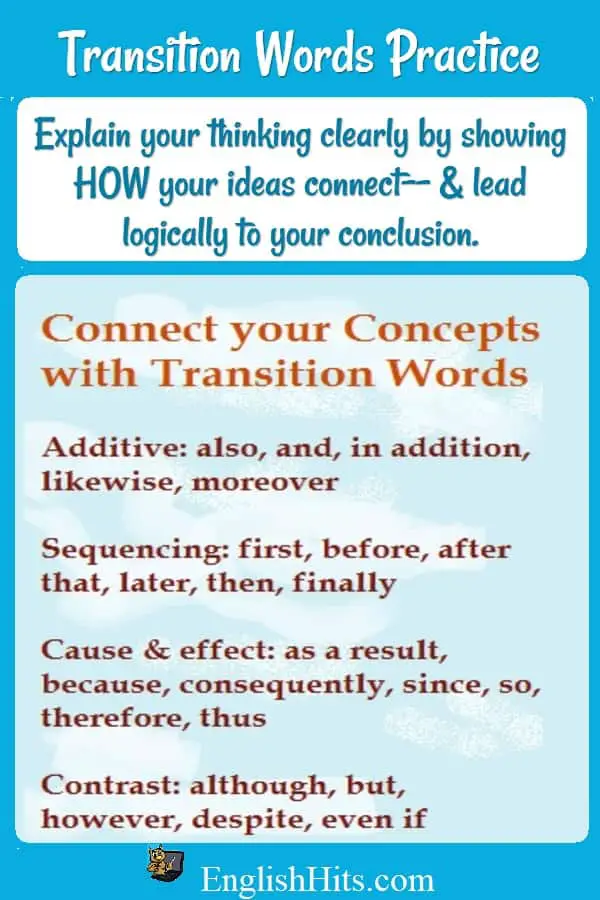Practice Using Transition Words
Transition words hold writing together. They help readers understand the connections between ideas or events. They explain the author’s thinking and show the path to his/her conclusions. That’s why it’s important to understand their meanings and use.
Types of Transitional Words (with examples)
· Additive words show a continuation or extension of the author’s point. Examples: also, and, for example, furthermore, in addition, likewise, moreover
· Sequencing words show the order of events: first, second, third (etc.), before, after, after that, later, next, last, finally
· Cause and effect words show causal relationships. Some examples: as a result, because (of), consequently, it follows that, since, so, therefore, thus
· Contrast words mark a different perspective. They modify or even disagree with what was stated before. Examples: but, however, instead, nevertheless, on the other hand, still
· Some contrast words warn the reader that what follows is not the whole story, but an exception. Examples: although, even though, despite, even if, in spite of, though, while
These words are often used to admit that an opposing argument has some truth before showing that other factors are more important. Most of these words mean the same thing, though they fill different places in the sentence. (See "How to Use These Transition Words" below.)
How to Use These Transition Words
Using Adverb Transitions
Many of these words or phrases can stand alone as adverbs. (They modify or explain the whole sentence or phrase): also, for example, furthermore, in addition, likewise, moreover; first, second, third (etc.), later, next, last, finally, as a result, consequently, therefore, thus, however, instead, nevertheless, on the other hand, still.
Here are two example paragraphs.
Music lessons can benefit children in several ways. First, they introduce children to a potentially lifelong source of pleasure. They also teach rhythm, sensitivity to nuance, teamwork, and other values. Furthermore (or Moreover), there is evidence they can train the ear and help with language learning. As a result, parents should see the lessons as an investment, not just an expense.
On the other hand, forcing a reluctant child to spend hours on lessons may cause him to develop a lifelong dislike of music. Perhaps he or she might get more value from a different kind of music-- or a completely different activity. You could try a few lessons. if she still resists, try a different instrument instead. Finally, consider a completely different activity.
Prepositional Transitions
'Because of, 'before,' 'after,' or 'despite' (something), ‘in spite of, ’ ‘regardless of,’ and 'since' are prepositions when they are used before nouns or noun phrases.
Examples:
- Before the discovery of antibiotics, many people died of infections that now seem minor. Since then, the average life expectancy has gone up by several decades.
- Despite (or In spite of) their drawbacks, antibiotics have saved countless lives.
Conjunctions Showing Transitions
'And,' 'but,' 'or,' and 'so' are conjunctions that join words, phrases, or equal clauses. (A clause has both a subject and a verb. Two equal (or independent) clauses form a compound sentence.
- Music lessons can have great value, but they can hinder children's development if forced on them. So it may take trial and error to learn what works best for your child.
Subordinating conjunctions join unequal clauses. They precede a dependent clause. (That's a clause that cannot stand alone as a sentence.) If the dependent clause comes first, use a comma after it. (See examples below.)
Common subordinating conjunctions include: before, after, because, it follows that, since, although, even though, despite, even if, though, while.
(Notice that 'before,' 'after,' 'despite,' and 'since' can be conjunctions as well as prepositions. Many of these transition words can be used as several parts of speech. What matters is how they're used in the sentence.)
Some example sentences:
- Before she studied piano, Susie had difficulty concentrating on anything. She has shown remarkable improvement in focus since her lessons began. Despite the gains she has made, her father is questioning their value. Her mother has offered to give Susie the lessons herself because she wants Susie to continue. While she is able to teach, she won't let their cost prevent Susie's lessons
‘Even if’ is also a subordinating conjunction, but it has a different meaning than 'although' or 'even though.' It does not concede that something is true, but states that what follows applies whether or not the ‘if’ clause is true. Examples:
· Even though she was tired after work, Mary always cooked dinner for her family. (She was always tired, but she cooked anyway.)
· Even if she was tired after work, Mary always cooked dinner for her family. (Sometimes she was tired and sometimes she wasn’t, but in either case she cooked.)
Practice Connecting Words in this Essay
Use the words at the top or bottom of the essay to fill in the gaps (blanks) in this essay about online learning. (Remember to capitalize the first words of sentences and to check your spelling.)
Several blanks have more than one possible answer. Any of those will be marked correct. In your own writing, remember to vary your words, rather than repeating the same word each time that it could possibly be used.
(The words are repeated in the box below the essay so you can see them from the last paragraphs as well as at the beginning.)
Advantages and Disadvantages of Online Learning
Choose from: also, although, because, but, even, first, however, in addition, moreover, similarly
also, although, because, but, even, first, however, in addition, moreover, similarly
After trying to fill in all the gaps and checking your answers, you can see the complete essay (with all possible correct answers underlined in it) here.
You also can download a pdf of the practice exercise and answers to print for personal use if you have any difficulties with interactive version.
If you want more information, there’s a much more complete list of transition words from MSU. For more examples of their use, see the (gap-fill) essay in Conservation Terminology. For the less common transitional words used in the Academic Word List, see Linking Words in the AWL.
Home> Learn to Write English > Transition Words.
Didn't find what you
needed? Explain what you want in the search box below.
(For example, cognates, past tense practice, or 'get along with.') Click to see the related pages on EnglishHints.
| site search by freefind | advanced |






